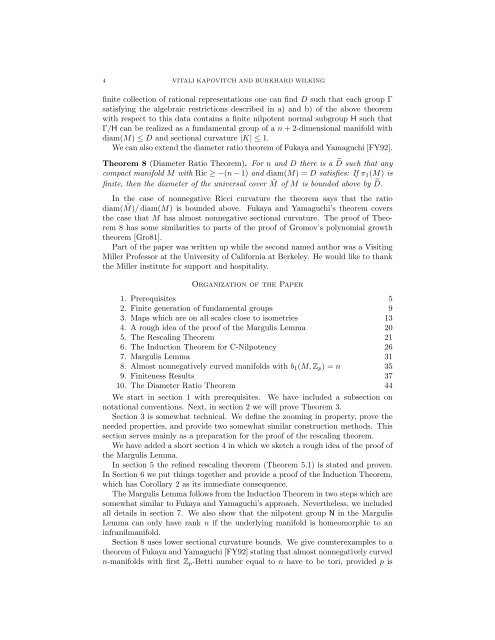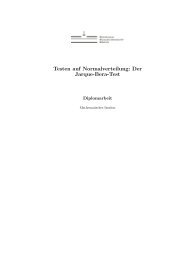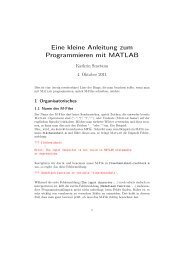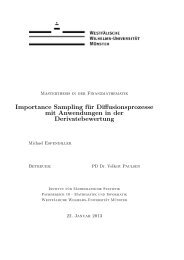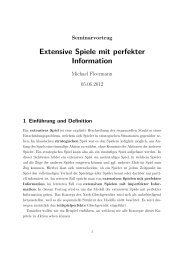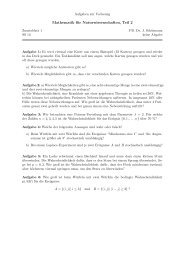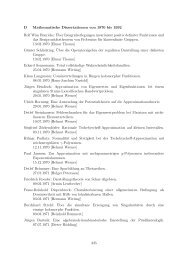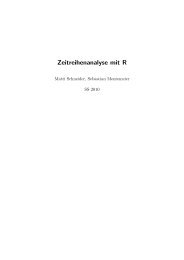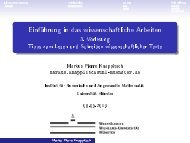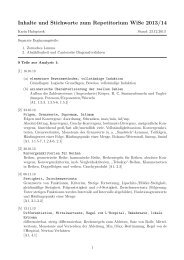Margulis Lemma
Margulis Lemma
Margulis Lemma
You also want an ePaper? Increase the reach of your titles
YUMPU automatically turns print PDFs into web optimized ePapers that Google loves.
4 VITALI KAPOVITCH AND BURKHARD WILKING<br />
finite collection of rational representations one can find D such that each group Γ<br />
satisfying the algebraic restrictions described in a) and b) of the above theorem<br />
with respect to this data contains a finite nilpotent normal subgroup H such that<br />
Γ/H can be realized as a fundamental group of a n + 2-dimensional manifold with<br />
diam(M) ≤ D and sectional curvature |K| ≤ 1.<br />
We can also extend the diameter ratio theorem of Fukaya and Yamaguchi [FY92].<br />
Theorem 8 (Diameter Ratio Theorem). For n and D there is a ˜D such that any<br />
compact manifold M with Ric ≥ −(n − 1) and diam(M) = D satisfies: If π 1 (M) is<br />
finite, then the diameter of the universal cover ˜M of M is bounded above by ˜D.<br />
In the case of nonnegative Ricci curvature the theorem says that the ratio<br />
diam( ˜M)/ diam(M) is bounded above. Fukaya and Yamaguchi’s theorem covers<br />
the case that M has almost nonnegative sectional curvature. The proof of Theorem<br />
8 has some similarities to parts of the proof of Gromov’s polynomial growth<br />
theorem [Gro81].<br />
Part of the paper was written up while the second named author was a Visiting<br />
Miller Professor at the University of California at Berkeley. He would like to thank<br />
the Miller institute for support and hospitality.<br />
Organization of the Paper<br />
1. Prerequisites 5<br />
2. Finite generation of fundamental groups 9<br />
3. Maps which are on all scales close to isometries 13<br />
4. A rough idea of the proof of the <strong>Margulis</strong> <strong>Lemma</strong> 20<br />
5. The Rescaling Theorem 21<br />
6. The Induction Theorem for C-Nilpotency 26<br />
7. <strong>Margulis</strong> <strong>Lemma</strong> 31<br />
8. Almost nonnegatively curved manifolds with b 1 (M, Z p ) = n 35<br />
9. Finiteness Results 37<br />
10. The Diameter Ratio Theorem 44<br />
We start in section 1 with prerequisites. We have included a subsection on<br />
notational conventions. Next, in section 2 we will prove Theorem 3.<br />
Section 3 is somewhat technical. We define the zooming in property, prove the<br />
needed properties, and provide two somewhat similar construction methods. This<br />
section serves mainly as a preparation for the proof of the rescaling theorem.<br />
We have added a short section 4 in which we sketch a rough idea of the proof of<br />
the <strong>Margulis</strong> <strong>Lemma</strong>.<br />
In section 5 the refined rescaling theorem (Theorem 5.1) is stated and proven.<br />
In Section 6 we put things together and provide a proof of the Induction Theorem,<br />
which has Corollary 2 as its immediate consequence.<br />
The <strong>Margulis</strong> <strong>Lemma</strong> follows from the Induction Theorem in two steps which are<br />
somewhat similar to Fukaya and Yamaguchi’s approach. Nevertheless, we included<br />
all details in section 7. We also show that the nilpotent group N in the <strong>Margulis</strong><br />
<strong>Lemma</strong> can only have rank n if the underlying manifold is homeomorphic to an<br />
infranilmanifold.<br />
Section 8 uses lower sectional curvature bounds. We give counterexamples to a<br />
theorem of Fukaya and Yamaguchi [FY92] stating that almost nonnegatively curved<br />
n-manifolds with first Z p -Betti number equal to n have to be tori, provided p is


